-

人教版新目标初中英语八年级下册What should I do教案2篇
说明:在帮Li Lei提建议的同时,教育学生如何学好英语。第三课时教学目标1. 语言目标:a) 词汇: Original, in style, haircut, the same as.b) 语言结构:My friend wears the same clothes and has the same haircut as I do.2. 能力目标:大多数学生能够谈论自己喜欢哪种服装,提高查找信息的能力。3. 情感目标:学会如何与朋友相处,要有自己对时尚的看法。教学重点掌握一些重要词汇。教学难点学会谈论问题,并能提出书面建议。◆教学突破首先针对Erin的问题,提出个人的建议,模仿2c部分的对话展开双人交际Pair-work;听老师诵读3a部分的信件,并找出LEFT OUT的问题所在;学生完成3b部分的内容,给Left Out提出书面的建议;学以口头形式提出自己目前存在的某个问题,讲给大家听,让同学们给自己提出一个建议,并作笔录;学生两、三个人分成一组,随意性地进行口语交际,谈论P14的第4部分的某个问题,相互交换意见。

人教版新目标初中英语八年级上册What’s the best radio station教案2篇
教学重点和难点:运用所掌握的语言描述,比较不同地点的特点。在练习中学习掌握英语比较级和最高级的用法。课前准备分配小组,每组五至六人。通过上网或翻阅报刊杂志等方法,确定旅游线路,做出基本的旅游计划。教学设计:本节课流程图 学法指导:1.由于这是一堂新课,在教学中应注意面向全体,发挥学生的主体性,引导学生积极参与,激发学生的求知欲和学习积极性,指导学生积极思维,主动获取知识,养成良好的学习方法。逐步学会独立解决问题。总之要尽可能调动学生的非智力因素促进智力因素的发展。教法选择:1.电化教学法2.课堂讨论法3.任务型教学法采用这些方法的目的是为了充分调动学生的学习积极性,使学生变被动学习为主动学习。通过电脑形象的演示,加强印象,提高兴趣,突破难点,提高教学效率,进而增大教学的容量和信息量。充分体现教师为主导,学生为主体的教学原则。

人教版新目标初中英语八年级上册What’s the matter教案2篇
She shouldn’t go to the party tonight.Step7. TaskT: You know, there are lots of problems in our life. If you are a doctor, please tell us how to solve the problem. I will divide you into 9 groups. Please work in groups. And then choose one of you to report your ideas.The following are the problems:I have a toothache.I am hungry. I have a sore throat.I am stressed out. I have a sore back.I am tired. I can’t sleep.I have a cold. I have a headache.Report: If you have a headache, you should go to bed early. You should see the doctor. You should eat some medicine. You shouldn’t wash your face with cold water.You shouldn’t sleep late.You shouldn’t swim.…..T encourages the students to give advice as much as possible.Homework:1. Chose one of the problems, and write down your advice2. Copy the new words这一步是用于热身的,同时也可以让他们复习一部分的表示人体部位的单词,扩充知识.学习语言的过程也是一个不断积累的过程,复习旧知识,增添新知识.通过小游戏,强化学生对Does she/he have…这个句子的运用能力.通过复习,自然的引到下面新知识的学习。充分利用表格,由句子到对话,再到文章,让学生循序渐进. 提高学生的综合语言运用能力,运用以前学过的知识来解决身边的问题.Period 5 (Section B 3a—3c, selfcheck)教学内容与分析:

人教版新目标初中英语八年级下册If you go to the party, you’ll have a great time教案2篇
区分宾语从句、定于从句和状语从句宾语从句和状语从句,都叫做主从复合句。宾语从句主要是中考必考的,是初中阶段必掌握的从句,宾语从句主要是掌握三要素,所谓宾语从句,就是宾语在主从复合句当中充当宾语的一个句子,叫做宾语从句。主句的谓语动词是及物动词,后面如果是词或者是短语的话,是简单句,如果是句子的话,肯定是宾语从句。I know that he good at English.就是宾语从句,三要素,一要素是要注意连词,连词一共学了三类连词,一类连词是that口语当中可以省略,就像刚才说的那一句,I hear he is good at English.还有疑问代词、疑问副词,how where when,疑问代词、疑问副词。还有一类连词weather是否的意思,不是状语从句当中的如果,这一定要和如果区分开,这是是否。I don't know if he interested at English。宾语从句要注意if是连词。第二要素是语序,要用陈述举语序。比如说你家有几口人,我们都说How many people are there in you family?但是这是简单句,一旦说成宾语从句,你可以告诉我你家有几口人吗?Could you tell me how many people there are in you family ?

人教版新目标初中英语八年级下册What were you doing when the UFO arrived教案2篇
(一).知识方面: 1.培养学生能运用过去进行时来描述、谈论过去某个时间正在发生的事情或动作的意识和能力,能就过去某个时间正在发生的动作做出正确的描述。 2.培养学生的想象力和角色扮演的合作能力。 3.培养学生讲述过去发生的事情经过的能力。能正确运用一般过去时来讲述故事。 (二).技能方面: 1.本单元的语言目标是Talk about past events and tell a story(谈论过去的时间和讲述一个故事),围绕这一目标,要涉及句型: What were you doing when the UFO arrived? ----I was sitting in the barber’s chair. The barber was cutting my hair. 因此必须学习standing、studying、cleaning、sleeping、cooking、making、eating、cutting、等表示地点的词,以便为上述句型提供语言材料。2.学习过去进行时的有关知识。Was/were+现在分词,是该时态的表达式。 3.在学习过程中,要区分The boy was walking down the street when the UFO landed.和While the boy was walking down the street, the UFO landed.这两种由when和while引导的状语从句的句型结构。注意它们的不同。

人教版新目标初中英语八年级下册Would you mind turning down the music教案
Step 4. Group work (4)1. Ask a pair of students to read the dialogue. Say, This activity provides speaking, listening and writing practice using the target language.2. Ask students to complete the work in groups.3. Check the answers with the whole class. 4. Explain some of the language points. Step 5. Word review (Self check 1)1. Ask students to read the words and the phrases given. 2. Fill in the blanks with proper forms of these words to complete the sentences. 3. Check the answers with the whole class. Homework:Do activity 2 on page 57 after class. Period 6Teaching aims: 1. Teach vocabulary words and the useful expressions. 2. Enable the students to learn etiquette in different culture. 3. Help the students learn how to behave politely in public places and in daily life. Teaching procedures:Step 1. RevisionHelp students to review the function of making requests through a free talk. Then lead them to the topic of etiquette. Explain the meaning of etiquette. Or, ask students to look it up in the dictionary. Step 2. Pre-reading (Section 1)1. Ask students to read the picture and make a list with their partner about how many rules of etiquette can be seen being broken.

人教版新目标初中英语九年级上册Teenagers should be allowed to choose their own clothes教案2篇
Step 1 Greeting Greet the class and check the homeworkStep 2 A duty report The S on duty gives a report on the rules in his home and lead in 3a “Sun Fei’s and Wu Yu’s rules” Step 3 ReadingSs read the conversation and write the two girls’ rules in the chart. Check the answers.Get Ss to read after the tape and then read aloud by themselves. Then, T explains the language points.Step 4 Pairwork 3bRole play. Use the information in chart to practice with the conversation in 3a covered. They can look at the sample conversation in the right box.Step 5 Task 2 “Who’s the best reporter?”Make a survey by asking any 5 students the questions in the chart in activity 4. Then give out a report about it. See who is the best reporter? And the best reporter will get a nice ball-pen.Step 6 Summary and homework:Write out the report in your exercise-books.Period ThreeStep 1 Greeting and a duty reportThe S gives a duty report talking about his experience of being late for school. Lead in the question “Do you ever get to school late? How often do you get to school late? Always, usually, sometimes, or never?Step 2 1a Get Ss to finish writing.Step 3 Pairwork 1b Get Ss to talk about their answers with their partners using the sample conversation in the box on the right.Step 4 Listening practice2a Lead-in: What will happen if you get to school late? What about Peter? Let’s listen to a conversation between Peter and his father. Get Ss to finish 2a (As usual, for the first time, Ss only listen.) Check the answers.

人教版新目标初中英语九年级上册I like music that I can dance to教案
教学目标: 1. Express preferences2. Talk about one’s likes and dislikes and the reasons3. Learn to express one’s opinions 4. Learn to write a reply 语言功能: 1) Talk about one’s preferences, using t he relative clause2) Talk about people’s likes and dislikes and the reasons3) Talk about opinions语言结构: Relative clauses with that and who语言目标:What kind of music do you like?I like music that I can sing along with.I love singers who write their own music.We prefer music that has great lyric.重点词汇及短语:heart, photography, interest, class, whatever, miss, okay, expect, sweet, taste, itself, laboratory, cancer, increase, biscuit, main, care, prefer… to…, remind somebody of …, dance to, sing along with, be sure to, interest somebody, make somebody adj., to be honest, suit somebody, on display, catch up教学重难点:What do other people think of the different kinds of things? How to express one’s opinions? 学习方式:讨论,合作学习情感目标:通过本单元的学习,能提高学生的艺术鉴赏能力和审美情趣,并引导学生养成健康的饮食习惯。课时安排5课时第一课时:Section A: 1a-2c第二课时:Section A : 3a-4第三课时:Section B:1-2c, Self check2第四课时:Section B: 3a-4, Self check1第五课时:Self check ReadingI like music that I can dance to.

人教版新目标初中英语九年级上册How do you study for a test教案2篇
内容提示本单元主要内容是学会利用verb十by/with gerund表示方式方法来讨论学习英语的策略,认识自己在学习方面的长处和不足。初步了解现在完成时的结构和用法。现在完成时由助动词have/has+动词的过去分词构成,主要表示过去发生的某一动作对现在仍有影响或造成的后果,常与already,yet,just,ever,never等副词连用。教学目标一、学习目标(Language Goal) 1. Talk about how to study . 学会讨论各种学习方法和策略。2. Find out your suitable learning methods. 找出适合自己的学习方法。 二、语言结构(Language Structures) 1. Verb + by with gerund by+动名词短语 表示“通过…途径,方法” 2. How questions have引导的特殊疑问句 三、目标语言(Target Language) 1. How do you study for tests ? 你是怎样准备考试的?Well , I study by working with my classmates. 哦,我和同学们一起学习。2. Have you ever studied with a group ? 你曾经参加过学习小组吗?Yes , I have . I’ve learned a lot that way . 是的,参加过。通过这种方式我学了许多。

人教版新目标初中英语九年级上册It must belong to Carla教案
一、Section A该部分有4个模块。第一模块围绕Whose volleyball is this? 这一话题展开思维( 1a)、听力(1b)、口语( 1c)训练;第二模块围绕上一模块中的话题进行听力( 2a-2b)、口语训练( 2c);第三模块继续围绕前两个模块中的“making inferences”展开训练。训练形式为阅读排序( 3a)和两人问答(3b);第四模块仍就上一话题展开讨论。二、Section B该部分有4个模块。第一模块要求根据图画和所提供的单词写出合理的句子;第二模块在听力( 2a-2b)和分角色口语训练( 2c)的基础上,继续进行“推测”训练; 第三模块围绕“Strange events in Bell Tower neighborhood”这一话题展开阅读( 3a)和写作(3b -3c)训练;第四模块以dream为话题展开小组活动。三、Self Check该部分有3个模块。第一模块以填空形式对所学词汇进行训练;第二模块就8个谚语展开阅读和讨论。

人教版新目标初中英语九年级上册Where would you like to visit教案2篇
The First PeriodⅠ.Teaching Aims and DemandsKnowledge Objects(1) Key Vocabularytiring, educational, fascinating, thrilling, peaceful, exotic, trek, jungle, take it easy, explore, historic, site(2) Target LanguageWhere would you like to go on vacation?I’d like to trek through the jungle, because I like exciting vacations.2. Ability Objects(1)Train students to talk about places they would like to visit with the target language.(2)Train students to describe vacations with different adjectives.(3)Train students' listening skill.3. Moral Object,It′s more interesting to go on vacating somewhere instead of staying at home.Ⅱ. Teaching Key Points1. Key Vocabularytiring, educational, fascinating, thrilling, peaceful, exotic, trek, jungle, take it easy, explore, historic, site2. Target LanguageTalk about different places with the target language.Ⅲ. Teaching Difficult Points1. Describe vacations with different adjectives.2. Talk about different places with the target language.Ⅳ. Teaching Methods1. Teaching by illumination2. Teaching by doing chain drills3. Teaching by pairworkⅤ. Teaching Aids1. A tape recorder2. Some pictures of different places with famous views
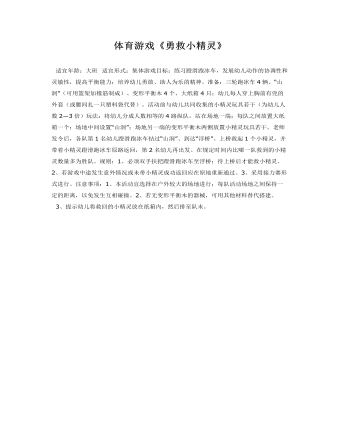
大班体育教案:勇救小精灵
培养幼儿勇敢、助人为乐的精神。准备:三轮跑冰车4辆、“山洞”(可用篮架加橡筋制成)、变形平衡木4个、大纸箱4只;幼儿每人穿上胸前有兜的外套(或腰间扎一只塑料袋代替)。活动前与幼儿共同收集的小精灵玩具若干(为幼儿人数2—3倍)玩法:将幼儿分成人数相等的4路纵队,站在场地一端;每队之间放置大纸箱一个;场地中间设置“山洞”;场地另一端的变形平衡木两侧放置小精灵玩具若干。老师发令后,各队第1名幼儿蹬滑跑冰车钻过“山洞”、到达“浮桥”。上桥救起1个小精灵,并带着小精灵蹬滑跑冰车原路返回,第2名幼儿再出发。在规定时间内比哪一队救到的小精灵数量多为胜队。规则:1、必须双手扶把蹬滑跑冰车至浮桥;待上桥后才能救小精灵。
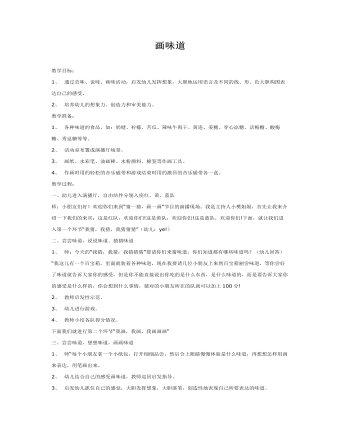
大班美术教案:画味道
2、 培养幼儿的想象力、创造力和审美能力。 教学准备: 1、 各种味道的食品,如:奶塘、柠檬、苦瓜、辣味牛肉干、黄连、姜糖、穿心凉糖、话梅糖、酸梅糖、秀逗糖等等。 2、 活动室布置成演播厅场景。 3、 画纸、水彩笔、油画棒、水粉颜料、棉签等作画工具。 4、 作画时用的轻松的音乐磁带和游戏结束时用的激昂的音乐磁带各一盒。 教学过程: 一、幼儿进入演播厅,自由结伴分别入座红、黄、蓝队 师:小朋友们好!欢迎你们来到“猜一猜,画一画”节目的演播现场。我是主持人小樊姐姐,首先让我来介绍一下我们的来宾:这是红队,欢迎你们!这是黄队,欢迎你们!这是蓝队,欢迎你们!下面,就让我们进入第一个环节“我猜,我猜,我猜猜猜”(幼儿:ye!) 二、尝尝味道,说说味道、猜猜味道 1、 师:今天的“我猜,我猜,我猜猜猜”要请你们来猜味道,你们知道都有哪些味道吗?(幼儿回答) “我这儿有一个百宝箱,里面就装着各种味道,现在我要请几位小朋友上来到百宝箱丽尝味道,等你尝好了味道就告诉大家你的感受,但是你不能直接说出你吃的是什么东西,是什么味道的,而是要告诉大家你的感受是什么样的,你会想到什么事情,猜对的小朋友所在的队就可以加上100分! 2、 教师启发性示范。 3、 幼儿进行游戏。 4、 教师小结各队得分情况。 下面我们就进行第二个环节“我画,我画,我画画画“
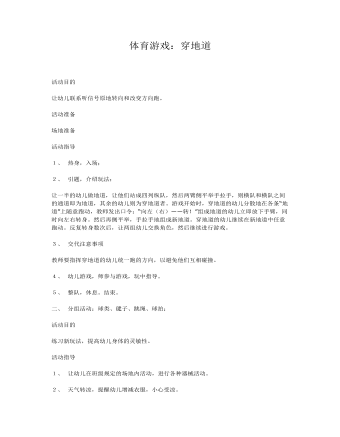
体育游戏:穿地道课件教案
2、 引题,介绍玩法;让一半的幼儿做地道,让他们站成四列纵队,然后两臂侧平举手拉手,则横队和横队之间的通道即为地道,其余的幼儿则为穿地道者。游戏开始时,穿地道的幼儿分散地在各条“地道”上随意跑动,教师发出口令:“向左(右)――转!”组成地道的幼儿立即放下手臂,同时向左右转身。然后再侧平举,手拉手地组成新地道。穿地道的幼儿继续在新地道中任意跑动。反复转身数次后,让两组幼儿交换角色,然后继续进行游戏。3、 交代注意事项教师要指挥穿地道的幼儿统一跑的方向,以避免他们互相碰撞。4、 幼儿游戏,师参与游戏,玩中指导。5、 整队,休息。结束。
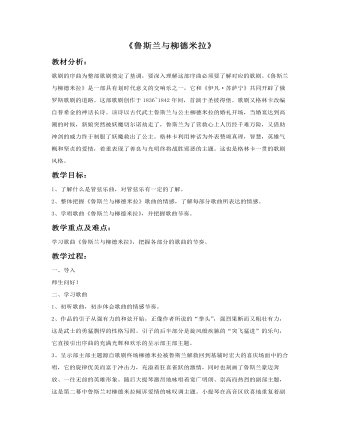
《鲁斯兰与柳德米拉》教案
歌剧的序曲为整部歌剧奠定了基调,要深入理解这部序曲必须要了解对应的歌剧。《鲁斯兰与柳德米拉》是一部具有划时代意义的交响乐之一,它和《伊凡·苏萨宁》共同开辟了俄罗斯歌剧的道路。这部歌剧创作于1836~1842年间,首演于圣彼得堡。歌剧又格林卡改编自普希金的神话长诗。该诗以古代武士鲁斯兰与公主柳德米拉的婚礼开场,当婚宴达到高潮的时候,新娘突然被妖魔切尔诺劫走了,鲁斯兰为了营救心上人历经千难万险,又借助神剑的威力终于制服了妖魔救出了公主。格林卡利用神话为外表赞颂真理,智慧,英雄气概和坚贞的爱情,着重表现了善良与光明终将战胜邪恶的主题。这也是格林卡一贯的歌剧风格。
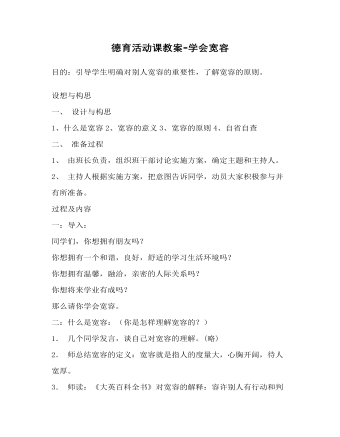
德育活动课教案-学会宽容
设想与构思一、 设计与构思1、什么是宽容2、宽容的意义3、宽容的原则4、自省自查二、 准备过程1、 由班长负责,组织班干部讨论实施方案,确定主题和主持人。2、 主持人根据实施方案,把意图告诉同学,动员大家积极参与并有所准备。过程及内容一:导入:同学们,你想拥有朋友吗?你想拥有一个和谐,良好,舒适的学习生活环境吗?你想拥有温馨,融洽,亲密的人际关系吗?你想将来学业有成吗?那么请你学会宽容。
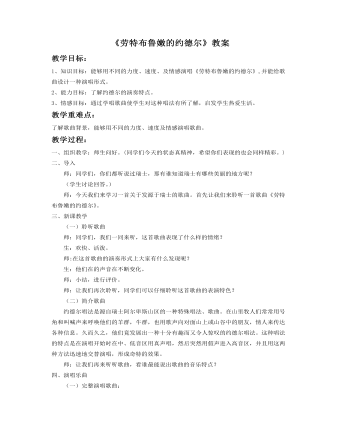
《劳特布鲁嫩的约德尔》教案
教学过程:一、组织教学:师生问好。(同学们今天的状态真精神,希望你们表现的也会同样精彩。)二、导入师:同学们,你们都听说过瑞士,那有谁知道瑞士有哪些美丽的地方呢?(学生讨论回答。)师:今天我们来学习一首关于发源于瑞士的歌曲。首先让我们来聆听一首歌曲《劳特布鲁嫩的约德尔》。三、新课教学 (一)聆听歌曲 师:同学们,我们一同来听,这首歌曲表现了什么样的情绪? 生:欢快、活泼。师:在这首歌曲的演奏形式上大家有什么发现呢?生:他们在的声音在不断变化。 师:小结,进行评价。 师:让我们再次聆听,同学们可以仔细聆听这首歌曲的表演特色?(二)简介歌曲约德尔唱法是源自瑞士阿尔卑斯山区的一种特殊唱法、歌曲。在山里牧人们常常用号角和叫喊声来呼唤他们的羊群,牛群,也用歌声向对面山上或山谷中的朋友,情人来传达各种信息。久而久之,他们竟发展出一种十分有趣而又令人惊叹的约德尔唱法。这种唱法的特点是在演唱开始时在中、低音区用真声唱,然后突然用假声进入高音区,并且用这两种方法迅速地交替演唱,形成奇特的效果。师:让我们再来听听歌曲,看谁最能说出歌曲的音乐特点?
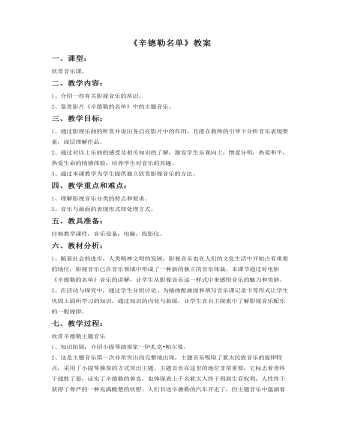
《辛德勒名单》主题音乐教案
教材分析:1、随着社会的进步,人类精神文明的发展,影视音乐也在人们的文化生活中开始占有重要的地位,影视音乐已在音乐领域中形成了一种新的独立的音乐体裁。本课节通过对电影《辛德勒的名单》音乐的讲解,让学生从影视音乐这一样式中来感悟音乐的魅力和美妙。2、在活动与探究中,通过学生分组讨论、为插曲配画面和填写音乐课记录卡等形式让学生巩固上面所学习的知识,通过知识的内化与拓展,让学生在自主探索中了解影视音乐配乐的一般规律。教学过程:欣赏辛德勒主题音乐1、知识拓展:介绍小提琴演奏家--伊扎克?帕尔曼。2、这是主题音乐第一次非常突出而完整地出现,主题音乐吸取了犹太民族音乐的旋律特点,采用了小提琴独奏的方式突出主题。主题音乐在这里的地位非常重要,它标志着善终于战胜了恶,证实了辛德勒的善良,也体现着上千名犹太人终于得到生存权利,人性终于获得了尊严的一种充满酸楚的欣慰。人们目送辛德勒的汽车开走了,但主题音乐中蕴涵着种种无法诠释的深重的情愫却久久难以让人忘怀。
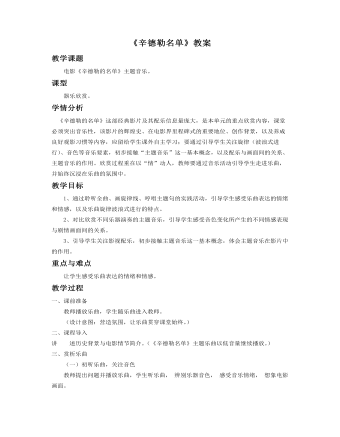
《辛德勒名单》主题音乐教案
教学过程一、课前准备教师播放乐曲,学生随乐曲进入教师。(设计意图:营造氛围,让乐曲贯穿课堂始终。)二、课程导入讲 述历史背景与电影情节简介。(《辛德勒名单》主题乐曲以低音量继续播放。)三、赏析乐曲(一)初听乐曲,关注音色 教师提出问题并播放乐曲,学生听乐曲, 辨别乐器音色, 感受音乐情绪, 想象电影画面。(二)再听乐曲,关注旋律(1)播放乐曲。(2)教师范唱主题句。(3)提问旋律线进行方式。(设计意图:引导学生体会乐曲旋律波浪式进行的特点以及主题音乐与影片的关系。)(三)视听结合(1)播放影片最震撼人心的“红衣小女孩”经典片段,提示注意影片配乐。(2)提问影片配乐与画面的关系,什么是“主题音乐”。(设计意图:引导学生加深理解影片主题音乐思想内涵、关注影片配乐与画面的关系。)
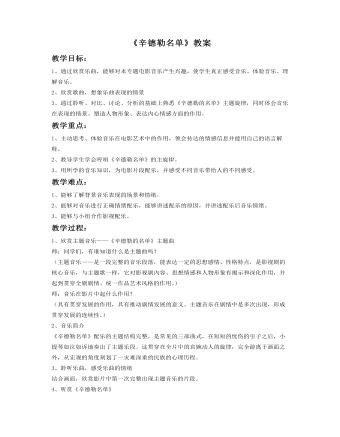
《辛德勒名单》主题音乐教案
教学过程:1、欣赏主题音乐——《辛德勒的名单》主题曲师:同学们,有谁知道什么是主题曲吗?(主题音乐——是一段完整的音乐段落,能表达一定的思想感情、性格特点,是影视剧的核心音乐,与主题歌一样,它对影视剧内容、思想情感和人物形象有揭示和深化作用,并起到贯穿全剧剧情、统一作品艺术风格的作用。)师:音乐在影片中起什么作用?(具有贯穿发展的作用,具有推动剧情发展的意义。主题音乐在剧情中是多次出现,形成贯穿发展的连续性。)2、音乐简介《辛德勒名单》配乐的主题结构完整,是常见的三部曲式。在短短的忧伤的引子之后,小提琴如泣如诉地奏出了主题乐段。这贯穿在全片中的哀婉动人的旋律,完全游离于画面之外,从宏观的角度刻划了一灾难深重的民族的心理历程。3、聆听乐曲,感受乐曲的情绪结合画面,欣赏影片中第一次完整出现主题音乐的片段。4、听赏《辛德勒名单》师:音乐开头用的什么乐器?音乐的主奏乐器是什么?你从中听出了什么情绪?5、随堂测验聆听一段音频回答音乐片段在影片中属于什么题材? 6、课堂小结影视音乐在影视作品中有哪些作用?

